Warning message and function control
Blind-Spot Collision Warning
First stage warning
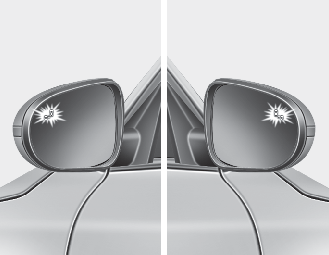
If a vehicle is detected within the boundary of the function, a warning light will illuminate on the outside rearview mirror.
Once the detected vehicle is no longer within the blind spot area, the warning will turn off according to the driving conditions of the vehicle.
Second stage alert
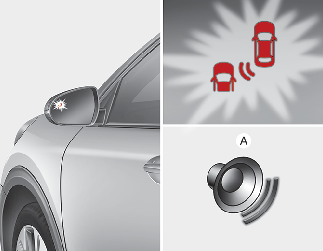
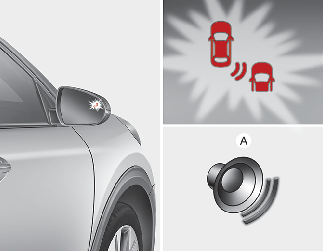
[A] : Warning sound
A warning chime to warn the driver will activate when:
-
At the First stage warning (the warning light illuminate on the outside review mirror AND
-
The turn signal is applied (same side as where the vehicle is being detected).
When this warning is activated, the warning light on the outside rearview mirror will also blink. And a warning chime will sound.
If you turn off the turn signal indicator, the second stage warning will be deactivated.
Once the detected vehicle is no longer within the blind spot area, the warning will turn off according to the driving conditions of the vehicle.

-
The warning light on the outside rearview mirror will illuminate whenever a vehicle is detected at the rear side by the function.
To avoid accidents, do not focus only on the warning light and neglect to check the vehicle surroundings.
-
Drive safely even though the vehicle is equipped with Blind-Spot Collision Warning. Do not solely rely on the function but check your surroundings before changing lanes or backing the vehicle up.
-
The function may not alert the driver in some situations so always check your surroundings while driving.

-
The driver should always use extreme caution while operating the vehicle, whether or not the warning light on the outside rearview mirror illuminates or there is a warning alarm.
-
Playing the vehicle audio system at high volume may offset Blind-Spot Collision Warning warning sounds.
-
The warning of Blind-Spot Collision Warning may not sound while other function’s warning sounds.
Detecting sensor
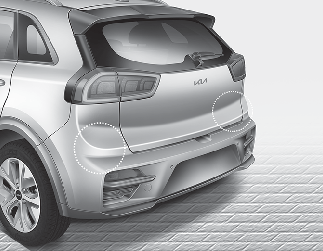
The rear corner radars are the sensors inside the rear bumper for detecting the side/rear areas. Always keep the rear bumper clean for proper operation of the function.

-
The function may not work properly when the bumper has been damaged, or if the rear bumper has been replaced or repaired.
-
The sensing range differs somewhat according to the width of the road. When the road is narrow, the function may detect other vehicles in the next lane.
-
The function may turn off due to strong electromagnetic waves.
-
Always keep the sensor or near the sensor clean.
-
Never arbitrarily disassemble the sensor component nor apply any impact on the sensor component.
-
Be careful not to apply unnecessary force on the radar sensor or sensor cover. If the sensor is forcibly moved out of proper alignment, the function may not operate correctly.
In this case, a warning message may not be displayed. Take your vehicle to a professional workshop and have the function checked. Kia recommends to visit an authorized Kia dealer/service partner.
-
Do not apply foreign objects such as a bumper sticker or a bumper guard near the radar sensor or apply paint to the sensor area. Doing so may adversely affect the performance of the sensor.
-
Never install any accessories or stickers on the front windshield, nor tint the front windshield.
-
Pay extreme caution to keep the camera sensor out of water.
-
Never locate any reflective objects (i.e. white paper, mirror) over the crash pad. Any light reflection may cause a malfunction of the function.
Warning message
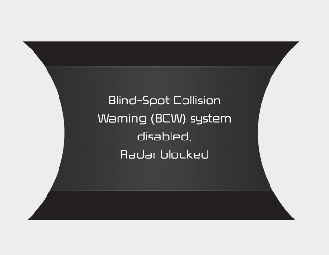
-
This warning message may appear when :
-
One or both of the sensors on the rear bumper is blocked by dirt or snow or a foreign object.
-
Driving in rural areas where the sensor does not detect another vehicle for an extended period of time.
-
When there is inclement weather such as heavy snow or rain.
-
If any of these conditions occur, the light on the Blind-Spot Safety button and the function will turn off automatically.
Turn off Blind-Spot Collision Warning when a trailer or carrier is installed.
-
Press the Blind-Spot Safety button (the indicator on the button extinguish)
-
Deactivate Rear Cross-Traffic Collision-Avoidance Assist by deselecting “User Settings → Driver Assistance → Blind-Spot Safety → Rear Cross-Traffic Safety”.
If you use Blind-Spot Collision Warning , remove a trailer or carrier.
When Blind-Spot Collision Warning canceled warning message is displayed in the cluster, check to make sure that the rear bumper is free from any dirt or snow in the areas where the sensor is located. Remove any dirt, snow, or foreign material that could interfere with the radar sensors.
After any dirt or debris is removed, Blind-Spot Collision Warning should operate normally after about 10 minutes of driving the vehicle.
If the function still does not operate normally, Kia recommend that you have your vehicle inspected by an authorized Kia dealer/service partner.
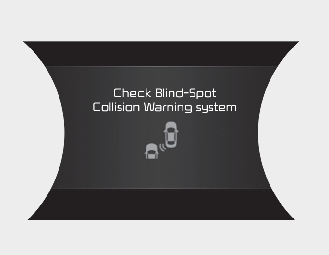
If there is a problem with Blind-Spot Collision Warning, a warning message will appear and the light on the switch will turn off. The function will turn off automatically.
In this case, have the function checked by a professional workshop. Kia recommends to visit an authorized Kia dealer/ service partner.
Limitations of Blind-Spot Collision Warning
The driver must be cautious in the below situations, because the function may not detect other vehicles or objects in certain circumstances.
-
When a trailer or carrier is installed.
-
The vehicle drives in inclement weather such as heavy rain or snow.
-
The sensor is polluted with rain, snow, mud, etc.
-
The rear bumper where the sensor is located is covered with a foreign object such as a bumper sticker, a bumper guard, a bike rack, etc.
-
The rear bumper is damaged, or the sensor is out of the original default position.
-
The vehicle height gets lower or higher due to heavy loading in a liftgate, abnormal tire pressure, etc.
-
When the temperature of the rear bumper is high.
-
When the sensors are blocked by other vehicles, walls or parking-lot pillars.
-
The vehicle drives on a curved road.
-
The vehicle drives through a tollgate.
-
The road pavement (or the peripheral ground) abnormally contains metallic components (i.e. possibly due to subway construction).
-
There is a fixed object near the vehicle, such as a guardrail.
-
While going down or up a steep road where the height of the lane is different.
-
Driving on a narrow road where trees or grass or overgrown.
-
Driving in rural areas where the sensor does not detect another vehicle or structure for an extended period of time.
-
Driving on a wet road.
-
Driving on a road where the guardrail or wall is in double structure.
-
A big vehicle is near such as a bus or truck.
-
When the other vehicle approaches very close.
-
When the other vehicle passes at a very fast speed.
-
While changing lanes.
-
If the vehicle has started at the same time as the vehicle next to you and has accelerated.
-
When the vehicle in the next lane moves two lanes away from you OR when the vehicle two lanes away moves to the next lane from you.
-
A motorcycle or bicycle is near.
-
A flat trailer is near.
-
If there are small objects in the detecting area such as a shopping cart or a baby stroller.
-
If there is a low height vehicle such as a sports car.
-
The brake pedal is depressed.
-
ESC (Electronic Stability Control) is activated.
-
ESC (Electronic Stability Control) malfunctions.
-
The tire pressure is low or a tire is damaged.
-
The brake is reworked.
-
The vehicle abruptly changes driving direction.
-
The vehicle makes sharp lane changes.
-
The vehicle sharply stops.
-
Temperature is extremely low around the vehicle.
-
The vehicle severely vibrates while driving over a bumpy road, uneven/bumpy road, or concrete patch.
-
The vehicle drives on a slippery surface due to snow, water puddle, or ice.
-
Driving on a curved road
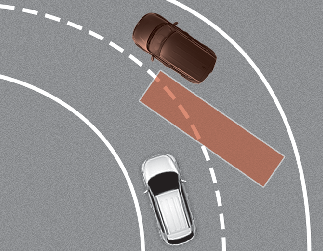
Blind-Spot Collision Warning may not operate properly when driving on a curved road. In certain instances the function may not detect the vehicle in the next lane.
Always pay attention to road and driving conditions, while driving.
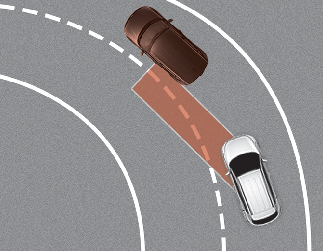
Blind-Spot Collision Warning may not operate properly when driving on a curved road. In certain instances the function may recognize a vehicle in the same lane.
Always pay attention to road and driving conditions, while driving.
-
Driving where the road is merging/dividing
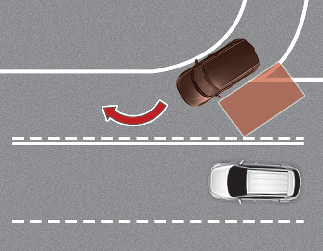
Blind-Spot Collision Warning may not operate properly when driving where the road is merging/dividing. In certain instances the function may not detect the vehicle in the next lane.
Always pay attention to road and driving conditions, while driving.
-
Driving on a sloped road
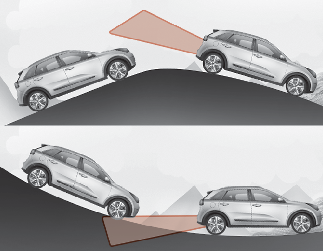
Blind-Spot Collision Warning may not operate properly when driving on a slope. In certain instances the function may not detect the vehicle in the next lane.
Also, in certain instances the function may wrongly recognize the ground or structures.
Always pay attention to road and driving conditions, while driving.
-
Driving where the heights of the lanes are different
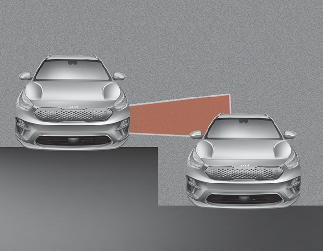
Blind-Spot Collision Warning may not operate properly when driving where the heights of the lanes are different. In certain instances, the function may not detect the vehicle on a road with different lane heights (underpass joining section, grade separated intersections, etc.). Always pay attention to road and driving conditions, while driving.
-
Driving where there is a structure beside the road
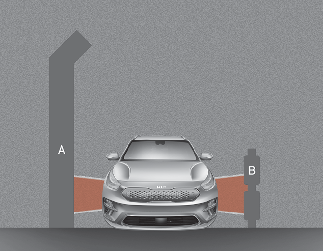
[A] : noise barrier, [B] : guardrail
Blind-Spot Collision Warning may not operate properly when driving where there is structure beside the road.
In certain instances, the function may wrongly recognize the structures (noise barriers, guardrail, double guardrail, median strip, bollard, street light, road sign, tunnel wall, etc.) beside the road.
Always pay attention to road and driving conditions, while driving.